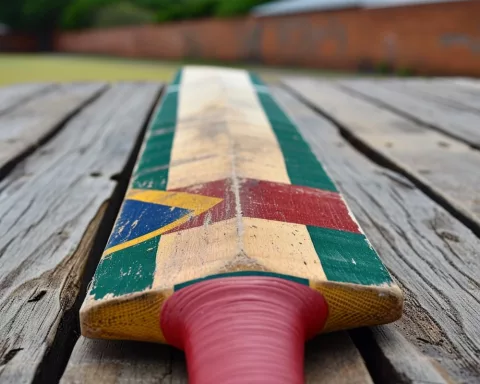Fakhar Zaman’s unbeaten performance of 126 runs off 81 balls, including 11 sixes and eight fours, helped Pakistan chase a revised DLS target of 342 in 41 overs against New Zealand, keeping their World Cup dreams alive. Pakistan needed to reach their original target of 402 runs within 35.3 overs to surpass New Zealand’s powerful net run-rate and secure their place in the semi-finals. South Africa’s Proteas also advanced to the semi-finals with a thrilling 21-run victory over New Zealand.
How did Fakhar Zaman’s unbeaten performance help Pakistan stay alive in the Cricket World Cup?
Fakhar Zaman’s outstanding performance of 126 runs off 81 balls, including 11 sixes and eight fours, helped Pakistan chase a revised DLS target of 342 in 41 overs. His aggressive playing style allowed Pakistan to amass 194 runs with captain Babar Azam (66) in an unbroken second-wicket partnership, securing their place in the semi-finals.
South Africa’s Proteas earned their spot in the Cricket World Cup semi-finals with a remarkable 21-run victory over New Zealand. The rain-soaked match at M. Chinnaswamy Stadium in Bengaluru also saw Pakistan’s World Cup dreams stay alive, thanks in large part to the powerful batting of Fakhar Zaman.
Zaman’s Unbeaten Performance
Fakhar Zaman, a skilled left-handed batsman, wowed the audience with his unbeaten 81-ball 126, hitting 11 sixes and eight fours despite the rain. Pakistan stood at 200-1 after 25.3 overs when the match was prematurely halted due to the weather, as they chased a revised DLS target of 342 in 41 overs.
New Zealand’s talented pair, Rachin Ravindra and Kane Williamson, played significant roles in their team’s total score. Ravindra scored his third century of the tournament, while Williamson hit an impressive 95, helping the Kiwis achieve a massive 401-6 in their 50 overs. Pakistan faced the formidable task of chasing an initial target of 402 runs, but Zaman’s outstanding performance raised their hopes.
Weather Interruptions and Zaman’s Continued Success
Before the 90-minute rain delay, Zaman led Pakistan to 160-1 after 21.3 overs. When play resumed, he continued his strong performance, striking three sixes off New Zealand’s spinner, Ish Sodhi, in the 25th over, pushing Pakistan past the 200-run mark.
For Pakistan to surpass New Zealand’s powerful net run-rate and secure their place in the semi-finals, they needed to reach their original 402-run target within 35.3 overs. Despite losing Abdullah Shafique early, Zaman and captain Babar Azam (66) formed an unbroken second-wicket partnership, amassing 194 runs.
Zaman’s incredible 39-ball fifty showcased his aggressive playing style, featuring four sixes and as many fours. He scored his 11th ODI century – and his first in a World Cup – with a six and a single off Mitchell Santner. His hundred included nine sixes and six fours, achieved within 63 balls.
New Zealand’s Strong Performance
Earlier in the match, Ravindra and Williamson provided a solid foundation for New Zealand’s impressive total. Ravindra’s 94-ball 108 included 15 fours and a six, while Williamson’s 79-ball effort featured two sixes and 10 fours. Ravindra’s consistent form came to an end when he was caught at deep mid-wicket off Mohammad Wasim in the 36th over.
Pakistan fielded four fast bowlers and two part-time spinners on the dry Chinnaswamy pitch, while New Zealand strengthened their lineup with leg-spinner Sodhi and three other slow bowlers, including the in-form Santner. The opening partnership of Ravindra and Devon Conway produced 66 runs before Conway fell to a short-pitched ball from Hasan Ali, ending his 35-ball 39.
Williamson, who had returned from knee surgery just before the World Cup, showed no signs of rust as he formed a 180-run partnership with Ravindra for the second wicket. Both Williamson and Ravindra were caught at long-off in quick succession.
Final Moments and Upcoming Semi-Finals
Daryl Mitchell (29) and Mark Chapman (39) added a quick 57 runs for the fourth wicket. However, Pakistan’s bowlers were unable to slow New Zealand’s scoring pace. Glenn Phillips contributed a 25-ball 41, and Santner hit two sixes in his 17-ball 26.
Pakistan’s standout bowler was Wasim with 3-60, but Shaheen Shah Afridi and Haris Rauf each gave up over 80 runs in their 10 overs, setting the worst-ever bowling figures for Pakistan in World Cup history.
Pakistan now have eight points from as many games and must win their final match against England on November 11th in Kolkata. They also rely on New Zealand losing to Sri Lanka on November 9th in Bengaluru or encountering rain disruptions.
South Africa’s Proteas will face India in an intense semi-final showdown at the iconic Eden Gardens in Kolkata tomorrow. As cricket enthusiasts worldwide eagerly anticipate the outcome, South Africa’s Proteas are on the verge of making history.
1. How did Fakhar Zaman’s unbeaten performance help Pakistan stay alive in the Cricket World Cup?
Fakhar Zaman’s unbeaten performance of 126 runs off 81 balls, including 11 sixes and eight fours, helped Pakistan chase a revised DLS target of 342 in 41 overs, securing their place in the semi-finals.
2. Why did Pakistan need to reach their original target within 35.3 overs to surpass New Zealand’s net run-rate?
Pakistan needed to reach their original target of 402 runs within 35.3 overs to surpass New Zealand’s powerful net run-rate and secure their place in the semi-finals.
3. How did Zaman perform during the rain delay?
Before the 90-minute rain delay, Zaman led Pakistan to 160-1 after 21.3 overs. When play resumed, he continued his strong performance, striking three sixes off New Zealand’s spinner, Ish Sodhi, in the 25th over, pushing Pakistan past the 200-run mark.
4. How did Pakistan chase the revised target despite losing Abdullah Shafique early?
Despite losing Abdullah Shafique early, Zaman and captain Babar Azam (66) formed an unbroken second-wicket partnership, amassing 194 runs, allowing Pakistan to chase the revised target of 342 and secure their place in the semi-finals.
5. Who were the standout performers for New Zealand in the match?
Rachin Ravindra, who scored his third century of the tournament, and Kane Williamson, who hit an impressive 95, were the standout performers for New Zealand in the match.
6. Who were the standout bowlers for Pakistan?
Mohammad Wasim was the standout bowler for Pakistan with 3-60, while Shaheen Shah Afridi and Haris Rauf each gave up over 80 runs in their 10 overs, setting the worst-ever bowling figures for Pakistan in World Cup history.
7. What does Pakistan need to do to secure their place in the semi-finals?
Pakistan now have eight points from as many games and must win their final match against England on November 11th in Kolkata. They also rely on New Zealand losing to Sri Lanka on November 9th in Bengaluru or encountering rain disruptions.
8. Who will South Africa’s Proteas face in the semi-finals?
South Africa’s Proteas will face India in an intense semi-final showdown at the iconic Eden Gardens in Kolkata tomorrow.












